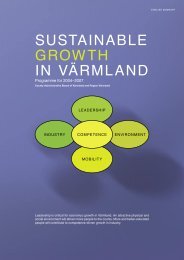successful partnerships a guide - Organisation for Economic Co ...
successful partnerships a guide - Organisation for Economic Co ...
successful partnerships a guide - Organisation for Economic Co ...
You also want an ePaper? Increase the reach of your titles
YUMPU automatically turns print PDFs into web optimized ePapers that Google loves.
<strong>successful</strong> <strong>partnerships</strong> a <strong>guide</strong><br />
5<br />
attract some of these key actors might turn out to be an ongoing weakness, limiting options of manoeuvre and<br />
endangering results. This is of course easier said than done. In many cases there will be interest groups that can<br />
easily agree on common targets but that mistrust other organisations and have no co-operation base with them.<br />
Then why should those interested in co-operating bother with the others – because often they will need<br />
the others to solve the problems.<br />
Once everybody is seated around one table, it is important to get <strong>for</strong>mal commitment, which a number<br />
of <strong>partnerships</strong> have solved through the signing of a partnership contract. It is an important step <strong>for</strong>ward when<br />
organisations of different background <strong>for</strong>mally sign an agreement to reach out across their respective<br />
responsibilities and interests and to co-operate on certain issues, especially when non-<strong>for</strong>mal partners (e.g. from<br />
civil society) are involved. To do this, partners have to share a vision. However, to succeed they also have to<br />
share a strategy; and to develop that strategy they have to agree on a shared analysis of the issues at stake.<br />
Some countries have chosen to develop a more <strong>for</strong>mal legal structure as a framework <strong>for</strong> <strong>partnerships</strong>. This<br />
clearly helps when it comes to tasks and rights, duties and responsibilities. As a prerequisite, the central or<br />
provincial level responsible <strong>for</strong> creating such a legal framework must have a vision on how to involve<br />
<strong>partnerships</strong> in overall policy. The question that remains however is, how much decision-making freedom will<br />
partners have once such a system is installed<br />
Improving work within a partnership<br />
Partnerships are <strong>for</strong>med <strong>for</strong> diverse reasons, and each has a “life” of its own. Even if everything<br />
functions well, it does so within a given context: whenever the situation changes and new tasks are assigned to<br />
a partnership, the conditions <strong>for</strong> its work and success change. One of the complicated issues within the life of<br />
a partnership, there<strong>for</strong>e, is the changing of partners (or of their involvement) and of tasks.<br />
A change in partners’ involvement happens relatively frequently, as the participation of each of<br />
the organisations involved depends to some extent on the personal commitment of their representatives and on<br />
how such representatives fulfill their roles and functions. Partnerships are organised as networks, and when<br />
members of the network change, the networks can change. This variable can be reduced by <strong>for</strong>mal contractual<br />
co-operation agreements, so that organisations and institutions are committed as bodies rather than as<br />
individuals. Nonetheless the variable exists, and should not be overlooked.<br />
Another factor that can pose problems is the admission of new partners. If <strong>partnerships</strong> exist <strong>for</strong><br />
a long period and become well established within their region, then at some point new partners will almost<br />
inevitably join. New tasks may come onto the agenda that call <strong>for</strong> the involvement of additional key actors<br />
(“voluntary admission”) – but also in some cases organisations outside the partnership may decide that<br />
co-operation is now advantageous (“requested admission”). In any case, admission mechanisms have to be in<br />
place <strong>for</strong> these eventualities, which will change the network configuration and make the direction of work harder<br />
to predict. Of course things can evolve in another direction, and partners may wish to resign. This can seriously<br />
hinder the future execution of the work programme, and to avoid a downward spiral, it may sometimes be<br />
necessary to redefine the framework of a partnership.<br />
Running a partnership is a very delicate operation requiring individuals who can really understand and<br />
work with different organisations and their requests. As the main task of <strong>partnerships</strong> is to find ways in which<br />
organisations – with their different tasks, responsibilities and approaches – can co-operate in dynamic societies,<br />
it is necessary to adapt methods and ways of working accordingly. Thus there has to be on the one hand<br />
a stable framework, and on the other hand a certain degree of flexibility to allow <strong>for</strong> all the necessary (and<br />
immediate) changes and adaptations. In addition there has to be strong communication, among the partners – so<br />
that there is maximum transparency both within and outside of the partnership.








